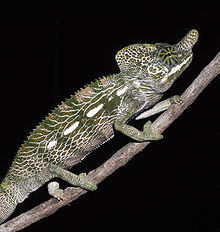Furcifer labordi
| Furcifer labordi | ||||||||||||
|---|---|---|---|---|---|---|---|---|---|---|---|---|

Furcifer labordi , male |
||||||||||||
| Systematics | ||||||||||||
|
||||||||||||
| Scientific name | ||||||||||||
| Furcifer labordi | ||||||||||||
| ( Grandidier , 1872) |
Furcifer labordi is endemic to Madagascar occurring chameleon -Art. The specific epithet honors the French adventurer and entrepreneur Jean Laborde, who lived in Madagascarin the 19th century .
features
Furcifer labordi , which belongs to the medium-sized chameleon species , reaches a total length of 308 millimeters including the tail in males. Females are much smaller and there is a clear sexual dimorphism . The sexes differ markedly in appearance, with the males showing greenish colors with white stripes on the flanks. Females, on the other hand, have a much more colorful appearance. The lively green of the body is patterned with purple and blue markings on the flanks, and bright orange drawings decorate the spine. Males are characterized by a high, bony head crest and a jagged scale crest on the back. Both sexes have conspicuous nasal processes, which are somewhat smaller in females and which essentially serve to identify the partner. The larger nasal processes in the males are also used as a weapon in turf wars.
distribution and habitat
The species occurs locally in the southeast of Madagascar in hot areas and low vegetation.
Way of life and development
The animals hatch in November from the eggs buried in the ground by their parents' generation. They develop extremely quickly and are sexually mature as early as January. After mating and laying eggs in February / March, the adult animals die again. With a lifespan of just four to five months, this is considered to be the shortest lifespan ever determined for a four-legged terrestrial vertebrate . The new generation develops in the eggs between March and November. Furcifer labordi therefore spends its short life a longer time inside the egg shell than outside it. It is assumed that the animals, in order to avoid the unfavorable conditions during the dry season, spend this time in the eggs and are thus better protected from environmental influences. The old and young animals feed on various insects that are ambushed by shooting out their long, sticky-tipped tongue. The Madagascar buzzard ( Buteo brachypterus ) and the snake species Ithycyphus oursi , Mahafalynatter ( Mimophis mahfalensis ) and Madagascarophis meriodionalis appear as predators of the species .
Danger
Since many habitats of Furcifer labordi are being destroyed by humans due to reclamation and agricultural expansion, the species is classified by the World Conservation Organization IUCN as ![]() ( vulnerable = endangered). The illegal removal of individual specimens from the wild and unlawful transfer to the pet trade also pose a certain threat to the species.
( vulnerable = endangered). The illegal removal of individual specimens from the wild and unlawful transfer to the pet trade also pose a certain threat to the species.
Individual evidence
- ↑ Origin of the name
- ↑ Information
- ^ A b Kristopher B. Karsten, Laza N. Andriamandimbiarisoa, Stanley F. Fox & Christopher J. Raxworthy: A unique life history among tetrapods: An annual chameleon living mostly as an egg. In: Proceedings of the National Academy of Sciences of the United States of America . Volume 105, No. 26, Ed .: James H. Brown, University of New Mexico, Albuquerque, NM, 2008, pp. 8980-8984 ( PDF ).
- ^ Red List
Web links
- Furcifer labordi in The Reptile Database
- eol.org - Encyclopedia of Life

